|
Photo: Tiny Earthstar:
Notice !
« Very small earthstar
« balloon in diameter 10-16 mm. (rare to 20 mm)
« star-rays 5-10 (that's a lot for the total size)
« balloon has a stem (max 1 mm long)
« mouth-zone is fibrillose (fimbriate)
« mouth-zone often has an elevated court
« mouth-zone often sharp limited by ring-furrow
« habitat-type moss-rich is one of the favorites
|
|
Tiny Earthstar
(Geastrum minimum Schweinitz)
Syn: Geastrum cesatii Rabenhorst
NMV Ga 211070
|
|
Habitat:
Tiny Earthstar is a pioneer in middle and inner dunes, especially in the neighbourhood of drifting sand.
Often places sometimes slithery of alges, moss-rich poor grass with tiny vegetation.
Also places with Hawthorn, Sea Buckthorn, and Common Dwarf Willow; there Tiny Earthstar is growing along the sand-pathes in the dunes
Tiny Earthstar is a pioneer, not loyal to one place, and certainly not a fairy-ring former.
Tiny Earthstar comes and goes, each time finding new appropriate places.
|
|
Regional:
Amsterdam urban area: no.
Pleistocene area: no.
Northsea dunal area: Dunal earthstar.
|
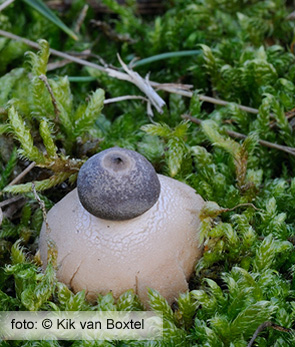
Photo: Mouth-zone: Often is not always |
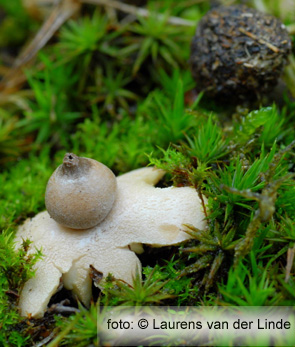
Photo: Notice the rabbit dung ... |
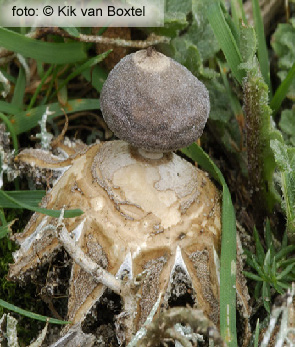
Photo: Only old and dry the stem is visible |
|
Mistakability Tiny Earthstar:
- Crowned Earthstar (Geastrum coronatum)
Often the balloon is broader than high,
court and mouth-zone color is equal to the balloon color.
- Dwarf Earthstar (Geastrum schmidelii)
Mouth-zone is plicate-furrowy. Baldy balloon,
stem is little bit longer (2 mm), format bigger (but thinner).
- Field Earthstar (Geastrum campestre)
Mouth-zone is plicate-furrowy (conical, and sharp limited by a ring-furrow, and lighter than the balloon),
stem is short, robust, pale (0,5-2 mm), apophyse is rounded bag-shaped, encrusted
debris is existing until late february, no scar, look-alike star-rays.
There are two clear different field-marks between Tiny Earthstar and Field Earthstar:
mouth-zone and balloon-surface. One can feel the difference !
|
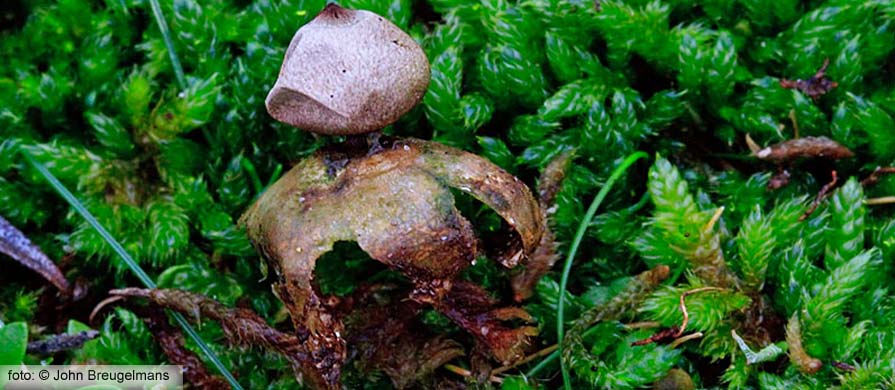
Photo: Notice stem and balloon-surface
|
How to exclude mistakability:
- Notice the elevation of the court of the mouth-zone
- Notice the court-color and the color of the mouth-zone (same as or lighter than the balloon-color)
- Notice the balloon-shape
- Notice the habitat-type
- Look at the bottom of the earthstar:
- Is earthar fixed to the ground (encrusted debris)
- Do the star-rays have a scar (should not be)
- If this is not helpful: dry the earthstar,
and see what changes during the dry-process: stem, apophyse, collar, mouth-zone
|
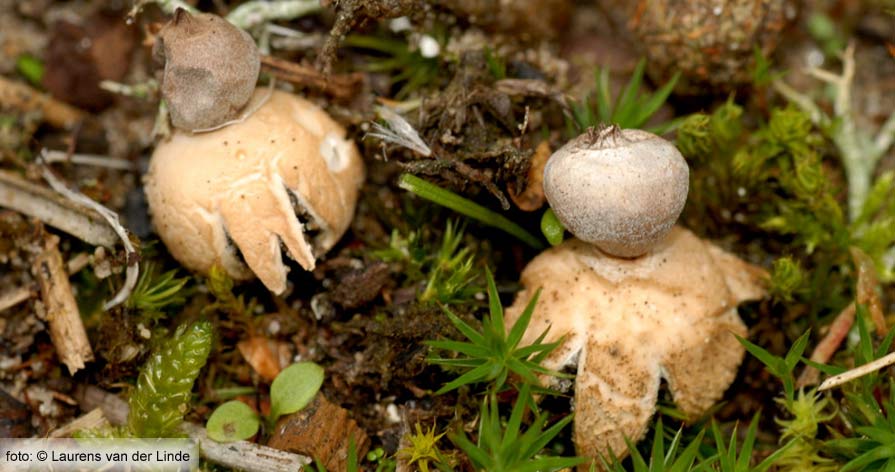
Photo: Rabbit dropping right back shows the scale. Tiny Earthstar is realy tiny.
|
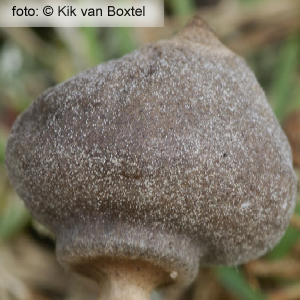
Photo: Apophyse: rounded bag-shaped |
Tiny Earthstar field-marks:
- Species size: very small
- Stem (below balloon): short, slender-solid, pale, apophyse rounded bag-shaped
- Balloon-in-diameter: 3-12 mm.
- Balloon-surface: floury (fine white cristalline, older disappearing grains)
- Balloon-shape: ofter higher than broad
- Balloon-color: young light-grey, crème. light-brown, sometimes dark-grey or dark-brown
- Balloon-mouth-zone: fimbriate, (often on an elevated) court, (flat to) conical, and often with ring-furrow
- Balloon-mouth-zone: color of count and mouth-zone lighter than balloon-color
- Star-rays-number: 6-12
- Star-rays-in-diameter: 0.8-4 cm.
- Star-rays-thickness: fresh upto 2 mm.
- Star-rays-top: color young creme, light-beige, older brown, skin peeling off
- Star-rays: encrusted debris
- Star-rays-scar: no
- Star-rays: non-hygroscopic (rays-tips sometimes are curling)
- Star-rays-bottom: color grey, bald after encrusted debris is gone
|
Literature:
Chrispijn, R. ed. (1999), Champignons in de Jordaan (De paddenstoelen van Amsterdam), Schuyt en Co, 162-163.
Gerhardt (2006), De grote Paddenstoelen Gids (voor onderweg), Tirion Natuur, 616.
Hansen, L & K. Knudsen (1997), Nordic Macromycetes, Kopenhagen, Vol 3, 345.
Jalink (1995), De aardsterren van Nederland en België, Coolia 38 supplement, 59-60.
Pegler, e.o. (1995), British puffballs, earthstars and stinkhorns, an account of the british gasteroid fungi, Royal Botanic Gardens, kew, 1995, 255 pp.
Vermeulen (1999), Paddestoelen, Schimmels en Slijmzwammen van Vlaanderen, Wielewaal, Turnhout, 541.
www.mycobank.com
|
Top
|